Global Spine Congress 2017 Milan
With just a little more than one month left to go, the preparations for the Global Spine Congress (GSC), which will be held from May 3–6, 2017 in Milan, Italy, are in full swing.
This edition of the GSC will feature a unique scientific program, with parallel sessions covering more than 25 topics, and showcase the latest technologies and cutting-edge innovations in spine surgery. This year, a record number of abstracts (1,048) were submitted. The event’s scientific program will include pre-courses, AOSpine symposia, and society symposia. In addition, peer-reviewed paper sessions will be presented as either oral or ePoster presentations, and there will be AOSpine Members-only sessions on various topics.
The congress is open to all surgeons, spine practitioners, allied health care professionals, and researchers.
Don't miss out on this opportunity to join the GSC. The pre-courses are now open for registration. Make sure to register soon, as limited places are available.
View the program, and register for the pre-courses and the GSC
Discounts apply for AOSpine Members, medical or research students, residents, fellows, and attendees from low-income countries.
AOSpine looks forward to welcoming you to Milan!
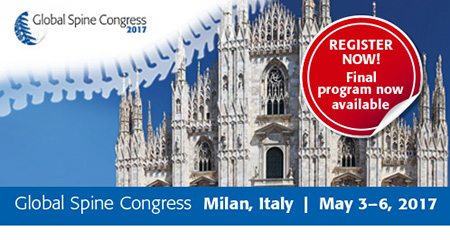
Your vote counts!
Help shape the future of AOSpine
Elect the AOSpine Member Representative at the Election Session on Friday May 5th, 2017 from 7.00-08.00am at the Global Spine Congress
Reporting to the Chairperson AOSpine International Board (AOSIB), the Member Representative will be the voice of all AOSpine members on the International Board. The Member Representative will serve for two years: One year with member elect status (guest without voting rights), and one year as a full member of the AOSIB with voting rights.
The application deadline for the position was February 12th, 2017. AOSpine will soon announce the eligible candidates, which have been validated by the Nomination Committee Jeff Wang ( Past Chairperson), Klaus Schnake (Chairperson Community Development) and CC Wong, Regional (Chairperson Asia Pacific). Successful candidates will be informed and asked to prepare a short talk on their motivations and goals for the Member Representative position at the Members Assembly.
Election process
This unique leadership position will be democratically elected by all voting members of AOSpine who attend the Members Assembly at the Global Spine Congress in Milan. All (present) voting members will have one vote, to be cast anonymously via e-Voting system. All AOSpine members who have been members for at least 3 consecutive years qualify for being Voting Members.
The winning candidate will need to get the majority of the votes. If none of the candidates reaches the necessary majority in the first round, a second round will be run. Depending on the numbers of candidates several rounds (up to max 4 rounds) can take place.
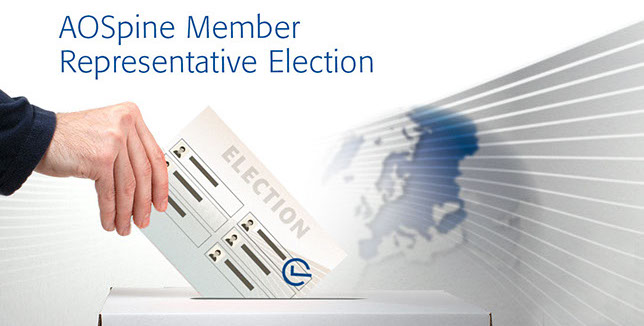
Call all Past Fellows!
Calling all Past Fellows! The Global Spine Congress in Milan is the place to be this year as we are forming an AOSpine Past Fellows Alumni group, have exclusive sessions dedicated to past fellows and a reception will be held specifically for this group of valued members.
On Friday 5th May (7pm–8pm) a social reception will be held at the congress for all AOSpine Past Fellows. During this reception we will be formalizing the creation of an AOSpine Past Fellows Alumni group open to all who have participated in an AOSpine Fellowship. A focus group of Past Fellows has been set up since last year's GSC and the final decision about the group's strategy and governance will be made during the congress in Milan by those present at the reception. Please be sure to attend to make your voice heard.
Additionally on Friday 5th May there will be two sessions designed specifically to the needs of Past Fellows:
10:30am – 11:30am: AOSpine Past Fellows Research Session. This is a networking session providing a platform for researchers to share their current projects and proposals, encouraging further development and collaboration.
11:30am – 12:30pm: Meet the AOSpine Past Chairpersons! Join John Webb, Max Aebi, Luiz Vialle and Jeffrey Wang for a special session aimed directly at Past Fellows sharing their experiences in the organization and offering tips and tricks on how to get more involved as well as career advice from some of the biggest names in spine surgery.
Throughout the congress all Past Fellows will also have access to the first AOSpine Fellowship Corner where all accepted abstracts will be on display in e poster format. The area will be exclusively for Past Fellows and will be designed to allow you and your peers to meet, share ideas and get to know each other.
Never before have so many opportunities been designed exclusively for this group of surgeons. Don't forget to register!
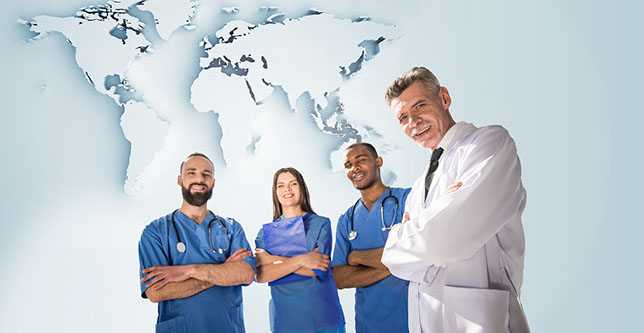
An Update on a Guideline Project for the Management of Degenerative Cervical Myelopathy and Acute Traumatic Spinal Cord Injury
While both acute traumatic and chronic compressive spinal cord pathologies have been recognized for centuries, many fundamental questions remain about their optimal management. These include such seemingly basic questions as: What is the natural history of neurologic decline (in chronic degenerative cervical myelopathy DCM) or recovery (in traumatic spinal cord injury (SCI))? And what are the best diagnostic modalities and how do these inform treatment decisions? Intrinsically linked to these enquiries is the basic question surrounding the role of decompressive surgery in stabilizing or improving neurologic function. What surgery (if any) should be performed? What are the clinical results of such an invasive intervention in terms of altering the natural course of neurologic recovery or decline? If it is to be performed, when would be the optimal timing for surgical intervention? Furthermore, questions remain about the efficacy of other potential treatments aside from surgical decompression. Might there be medical therapies that could influence neurologic outcome and/or rehabilitative interventions that could promote functional recovery?
As a result of these significant knowledge gaps, AOSpine, in collaboration with other societies, undertook an initiative to develop clinical practice guidelines to outline how to best manage patients with DCM and traumatic SCI. In order to do this, systematic reviews were first conducted to summarize the current body of evidence and to address the aforementioned clinical questions. Second, a multidisciplinary guideline development group used this knowledge, in combination with their clinical expertise to develop recommendations in a process that adhered to methodology proposed by the Grades of Recommendation, Assessment, Development and Evaluation (GRADE) WorkingGroup. This methodology allows for consensus building that extends beyond merely the strength of the available scientific evidence and considers other important factors such as feasibility, acceptability and a balance of risks and benefits.
For DCM, the guideline development group aimed to address the following clinical questions: should operative management be used to treat patients with moderate or severe myelopathy; should operative/nonoperative management be used to treat patients with mild myelopathy; and should operative management be used to treat nonmyelopathic patients with evidence of cord compression with/without signs or symptoms of radiculopathy. To formulate recommendations, the guideline development group considered disease natural history, the effectiveness of nonoperative versus operative treatment, the impact of preoperative duration of symptoms and myelopathy severity on treatment outcomes, predictors of neurological deterioration and risk factors of myelopathy development.
For traumatic SCI, this guideline revisited some of the most controversial questions of management, including the timing of surgical decompression and the use of high-dose methylprednisolone. The guideline also considered the role of magnetic resonance imaging in clinical decision-making and prognostication, the type and timing of anticoagulation strategies and the type and timing of rehabilitation.
Both guidelines are currently undergoing external review by a spectrum of organizations, expert clinicians and patient advocates.
These guidelines will be published as a special focus issue of the Global Spine Journal in spring 2017; the issue will consist of a summary of the methodology, results from the systematic reviews and a guideline document that includes recommendations and justification for these recommendations.
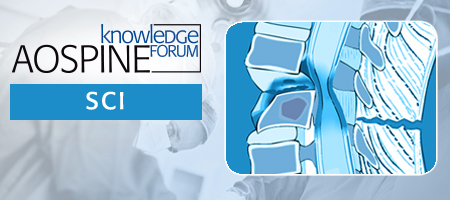
AOSpine Mentorship Education – The pilot experience!
In November 2015 the AOSpine Mentorship Education Scheme started taking applications for potential mentees to be connected with a mentor from within the organization. Initially mentees had to adhere to strict criteria and if they fulfilled these criteria they went through to the second stage which involved the AOSpine Mentorship Task Force scoring their CV's. A minimum score was required to proceed to the next stage in selection. All CV's were scored on attendance at AOSpine events, number of research presentations and number of research publications. The next stage of selection was based on the individual needs of the mentee. Only those with realistic goals were allowed through to the next stage of selection. During the application stage all potential mentees has to submit a statement detailing their expectations based on four competencies selected by them. An interview was then held and scored accordingly. Again a minimum score was required to proceed to the final stage of selection. Applicants were rated on their learning plan, assessment methods, forward planning and ability to overcome difficulties. During this part of the process it became clear to the interviewers that the scheme in itself was not entirely understood by the applicants and therefore AOSpine International has committed to promoting the pilot scheme in as much detail as possible to ensure future mentees are aware of the scheme and the rewards available from such a program. The final stage of the process was selection and acceptance by their chosen mentor. Mentees had their pick of 13 world renowned mentors from all over the world. In all three cases their mentors agreed to the matches and the program could start with initial online meetings between pairs. Due to the rigorous selection process only three mentees made it through out of the 22 who applied.
In August 2016 all three pairs met in New York City with educationalist Joseph Green, AOSpine Education Commission Chairperson Mike Grevitt and additional educational faculty Ted Choma. The aim of the meeting was for the mentees to create their own realistic personal goals for the scheme with their mentor. After this initial meeting the pairs will be in touch with each other virtually for around one year. The mentees will receive support from their mentors on topics such as setting up research projects, getting more involved with AOSpine and learning how to write research papers.
After the initial one year period the mentee will visit the mentor in their institution for a period of up to 12 weeks, working side by side with their mentor and getting more hands-on practical experience from the program. Following this experience we hope the pairs will remain in touch for a further one year, although AOSpine will be keeping a close eye on the project and its effectiveness as a learning tool. Several evaluations metrics have been set up to ensure what we offer to our community is the best we can offer.
The AOSpine Mentorship Task Force is considering opening applications for a second pilot however due to the high cost of resources involved with this program we must ensure proof of concept before allowing others to join the scheme. It is imperative AOSpine channels the resources it has into effective and innovative education.
The mentor and mentee pairs were asked to share their experiences with the scheme so far:
 Alex Vaccaro (Mentor): "New York was invaluable and my Mentee and I discuss electronically cases each week and it is going well."
Alex Vaccaro (Mentor): "New York was invaluable and my Mentee and I discuss electronically cases each week and it is going well."
 Ghazwan Hasan (Mentee): "(New York) really it was great meeting, and I got lots of benefit to meet with the team of Mentorship including my Mentor. I started to apply and work on the plan that we drew up during our meeting in the following points: We finished the proposal of 3 papers and I started to collect the data for the articles. I'm submitting all the cases that I'm doing or assist in my city in spine tango registry system now I have more than 60 cases. I'm exchange the cases by mail weeklong and got wealthy opinion and feedback from my mentor. I will attend the AAOS annual meeting, which will be a chance to meet my mentor physically.
Ghazwan Hasan (Mentee): "(New York) really it was great meeting, and I got lots of benefit to meet with the team of Mentorship including my Mentor. I started to apply and work on the plan that we drew up during our meeting in the following points: We finished the proposal of 3 papers and I started to collect the data for the articles. I'm submitting all the cases that I'm doing or assist in my city in spine tango registry system now I have more than 60 cases. I'm exchange the cases by mail weeklong and got wealthy opinion and feedback from my mentor. I will attend the AAOS annual meeting, which will be a chance to meet my mentor physically.
 Jeff Wang (Mentor): "The meeting in New York was very useful in order to meet and get to know each other. This is critical in order to be able to establish a relationship and find out more about the other person. This served as an amazing foundation on which to build the mentorship relationship.
Jeff Wang (Mentor): "The meeting in New York was very useful in order to meet and get to know each other. This is critical in order to be able to establish a relationship and find out more about the other person. This served as an amazing foundation on which to build the mentorship relationship.
Since the meeting, we have been in regular contact and have discussed things that really matter at the time. I am always amazed how fun and interesting it is to be able to discuss all aspects of life, medicine/surgery and life challenges, as our discussions will range to all aspects of life. I find myself remembering my own early life and fellowship challenges and finding the balance between work and personal life. I find it very refreshing and unique."
 Roger Härtl (Mentor): "(New York) was a great meeting with a lot of good ideas and inspirations. Carolin will come in February to New York, and we also met in Davos. We want to work together on how to best integrate surgical simulation into training for minimally invasive spinal surgery. This came out of our work on the bioskills course in Davos in December."
Roger Härtl (Mentor): "(New York) was a great meeting with a lot of good ideas and inspirations. Carolin will come in February to New York, and we also met in Davos. We want to work together on how to best integrate surgical simulation into training for minimally invasive spinal surgery. This came out of our work on the bioskills course in Davos in December."
 Carolin Melcher (Mentee): "The meeting in New York was extremely useful as meeting in person is invaluable. On top the outline of the program became more clear and we were able to plan ahead with our mentors and maybe even get a new idea about our goals and the things we would like to achieve.
Carolin Melcher (Mentee): "The meeting in New York was extremely useful as meeting in person is invaluable. On top the outline of the program became more clear and we were able to plan ahead with our mentors and maybe even get a new idea about our goals and the things we would like to achieve.
Roger and I are working on cases on a regular basis and plan two scientific projects. I am flying to New York in February to move things further ahead and start working more closely with his whole team. I am really looking forward to it. On top of this we talk about things that are on our minds, about problems, success and things that didn’t go the right way on the phone and via mail. It works out just fine."
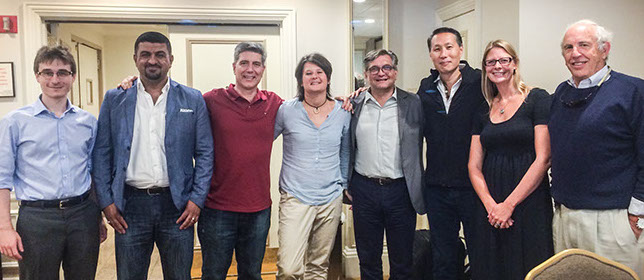
The first ever AOSpine mentees and mentors together with AOSpine staff and eductor who conducted the meeting. Left to right: Luigi Nasto, Ghazwan Hasan, Alexander Vaccaro, Carolin Melcher, Roger Härtl, Jeffrey Wang, Kate Quagliozzi, Joseph Green.
AOSpine is delighted to announce that Global Spine Journal has been accepted into SCOPUS
Scopus is the largest abstract and citation database of peer-reviewed literature: scientific journals, books and conference proceedings. Delivering a comprehensive overview of the world's research output in the fields of science, technology, medicine, social sciences, and arts and humanities, Scopus features smart tools to track, analyze and visualize research.
Find more information here
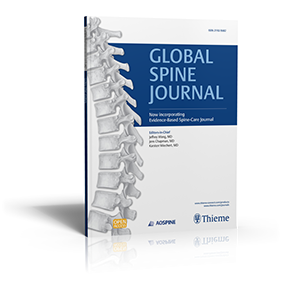

}
A Story of Success: AOSpine Community Growth in the DACH Region
2016 was a successful year for the AOSpine community in the German speaking countries. The so-called DACH region, consisting of Germany, Austria, and Switzerland, not only shares a common language, but also a mutual interest in increasing collaboration among the three AOSpine Country Chapters. This cooperation culminated in the very first AOSpine DACH event. Held in Frankfurt in June 2016, the event focused on complications in spine surgery, and brought together 80 interested spine surgeons.
In 2016, the chapters did not only succeed at a cross-country level, through the DACH event, but also within their respective countries. Robert Morrison, AOSDE Council officer for Community Development, shares: "The contribution of symposia to congresses seems to be an important ingredient for Germany's recipe for success. We need to keep up fostering our community and providing attractive events of high value for our members.”
Germany
AOSpine's two symposia at the DKOU (German Congress of Orthopedic and Trauma Surgery) attracted 320 surgeons, and over 200 participants attended the AOSpine Symposium—"Spondylodiszitis: Update aus der Praxis" at the DWG (German Spine Society). The significant turnout at both events contributed to a 106% increase in AOSpine Germany’s participant numbers in 2016, which totaled 649. This additional exposure also helped the German chapter gain new members, thus, Germany showed the highest number of new members within Europe. At the end of January 2017, AOSpine Germany has 271 members and the highest number of members within AOSpine Europe.
Austria
Austria was also very active participating at congresses in 2016. As a result, it was able to reach a much bigger audience. Events in Austria were attended by 168 participants, and the chapter expanded its community by 7.4% more members than in the previous year. In addition, AOSpine's Austrian council implemented a new concept for its Principles Courses, which is promising to keep up the country's success in 2017.
Switzerland
Switzerland had the second largest number of new members within the AOSEU Chapters in 2016, and the council stood out with extraordinary new concepts. This included the 2017 plan for the first peer-reviewed event, and a hospital needs assessment to support residents with AOSpine-developed tools.
Lorin Benneker, AOSCH Council Chairperson, sees a partial trend from global to local. "In Switzerland, the country where the AO Foundation and AO Spine had its origin, we realized that many Swiss surgeons have lost their connection to the AO community as the organization became more and more global. We have therefore started to organize local, short AO seminars with case discussions to help our surgeons to identify again with AO Spine, and to attract new members," Benneker concludes.
“With the support of AOSpine, we have successfully introduced weekly flipped classrooms for our residents,” shares Gregory Jost, AOSCH neuro officer. “Founding on AOSpine webinars, in-hospital cases are discussed, to practice and solidify new knowledge. This format brings in the spirit of AOSpine, and is highly efficient for both residents and senior surgeons This engagement already bears fruit, and AOSpine has been invited to be part of the academic program at the Congress of the Neurospine in Bern this year, we feel very honored”, he adds.


1 - 2
<
>
Increasing Membership Figures in AOSpine Middle East
AOSpine Members are the core of our community, and their commitment generates the impulse for development. Thus, we were honored to see increasing membership figures in broad parts of the Middle East. In 2016, two country chapters stood out with exceptional efforts to foster their national communities, and with an increase in membership figures that was above the ordinary. Egypt and Iraq differ in many ways, but are alike in their achievements for AOSpine Middle East.
Egypt: creating opportunities to share knowledge
Despite the plummeting Egyptian pound, the AOSpine Community in Egypt continues to gather and share knowledge and experiences at every possible opportunity. This happened at the recent 5th Aging Spine Congress in Cairo, which was chaired by AOSpine Regional Community Development Officer Youssry El Hawary: 60% of the 40 new members subscribed to AOSpine, in order to benefit from the free congress entrance for AOSpine Members. Under the guidance of AOSpine Egypt (AOSEG) Chairperson Mohamed Abdel-Wanis, the council runs regular local seminars in collaboration with universities and national societies to deliver updates on spine care. This has contributed to the increase in membership figures, which now stand at 166.
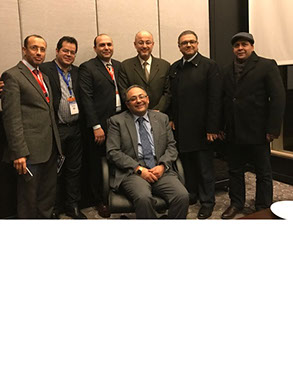
AOSEG Council Officers and Mohammad El-Sharkawi, AOSpine Regional Education Officer
Iraq: necessity is the mother of invention
The enthusiasm and eagerness for education in Iraq is as impressive as the unconditional commitment towards AOSpine from our Iraqi community. Although the security situation has calmed down in large areas of the country, the Iraqis still face problems, such as the frequent impossibility to carry out international bank transfers or credit card payments. This keeps many interested people in Iraq from renewing or initiating their membership. As AOSpine staff are not permitted to travel to Iraq, which would enable the local community to pay on-site, the council has found an efficient solution: surgeons can settle their fee with a AOSpine Iraq (SOSIRQ) Council Officer, who would then hand this over to AOSpine at the next possible meeting. Necessity is the mother of invention, and the Iraqis have learned to deal with all kinds of circumstances. AOSIRQ council's engagement has borne fruit, increasing their membership figures within one year by 43% to 116 members. Iraq now holds the second highest membership figures after Egypt, and the council deserves to be proud of its achievements.
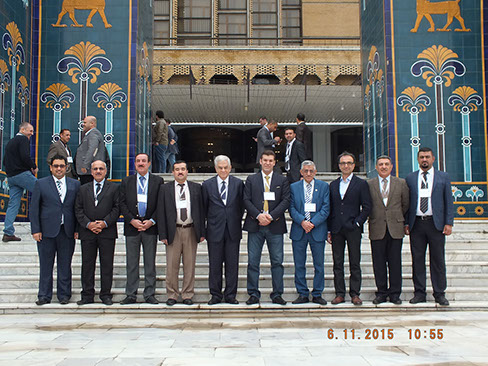
AOSIRQ Council Officers with the faculty of the AOSpine Principles Symposium—Spinal Trauma and Infection, Baghdad, Iraq, November 5-6, 2015.

"Best Association Newsletter" award for the AOSpine
Harry Weil, Head of International Business, StreamAMG, hands over the award to Regula Bleuler, AOSpine newsletter editor and writer
We are delighted to announce that AOSpine has won the award for "Best Association Newsletter" for the AOSpine newsletter at the European Association Awards. The award ceremony took place last Friday, 24th of Feb, 2017 in Brussels, Belgium.
The European Association Awards 2017 have been developed in recognition of excellence and exceptional achievements in European trade and professional associations. The judging panel included Secretary Generals from leading European Associations. Earning a European Excellence Award is a significant accomplishment, and reflects the exceptional efforts and outstanding results the associations have achieved.
Klaus Schnake, Community Development Chairperson and Editor-in-Chief, commented:" This is an important milestone for us and I am very proud of the achievement. I would like to congratulate the Community Development team under the lead of Ginesa Aviles for the great news. "
AOSpine Executive Director Jayr Bass, added: "I am proud of the team. It shows that the resources we have invested in the newsletter are well worth it, and that AOSpine is delivering a first-class newsletter to its members, in both content and design."
Regula Bleuler, Newsletter editor and writer shares: "I'm delighted about the award. I would like to thank the surgeons who have taken their valuable time to give interviews, share their stories and provide us insights with their contributions. It would have not been possible to deliver the newsletter content in such a high quality without their support".
The program recognizes exceptional achievements and campaign excellence taking place throughout Europe, at both in-country and pan-EU levels. Winners were chosen from among more than 60 finalists, and include both individuals and teams who have worked to ensure their organization’s members’ voices are heard.
